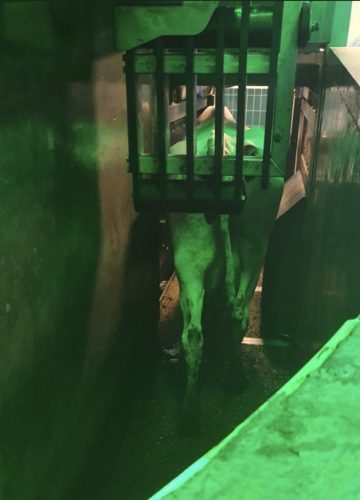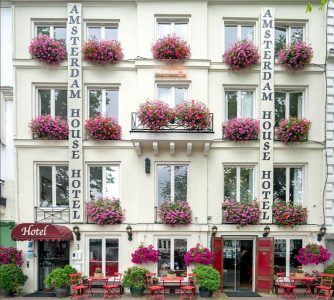Today we had an online meeting with a team from Gosschalk, the developers of the ‘Argus VCA camera-system’ and Dr. Temple Grandin. We wanted Temple Grandin’s recommendations on the handling and design in Gosschalk, where both cattle and pigs are slaughtered, to see if stress and fear could be further reduced. Temple Grandin is a well-known ethologist and expert on how to design according to animal behavior, so that fear and stress are at least kept to a minimum during slaughter. Together we watched videos of the pig and cattle process, from unloading to stunning.
Temple repeatedly said she was impressed by the design and calmness inside the slaughterplant. The use of several offset steps to move pigs to the single file raceway, worked very well in her opinion. On a few matters she was critical. Her most important recommendations and tips:
- Move pigs in smaller groups – so there will be less stress, less jamming and fewer pigs walking backwards. The raceway should only be at half capacity at any one time.
- Better timing of the process – only move pigs forward when there is space up ahead in the raceway. Temple calls this “timing of bunches”. She stipulates the importance of pigs being able to continue walking at all times and never have to wait. Waiting will cause them to turn around and get confused or nervous.
- The door in front of the stunning-box for cattle needs to slide higher up compared to its current height. When taller cattle enter the box, their backs slightly touch the bottom of the sliding-door, risking them to balk and refuse to walk further. Cattle, as well as pigs, are very sensitive when something touches their backs (it gives them the feeling they do not fit in).
- There were some distractions around the stunning box, risking cattle to become nervous, such as metal strips on the floor and a white bar in front of the box. Temple recommends removing these things that cause strong contrasts.
- The waving of a flag on a stick to move cattle more easily without having to enter with your body into their flight-zone.
- Animals will stare at the object they fear. Pay close attention to this behavior – it tells you what needs to be changed/adjusted. Objects that cause fear need to be removed.
- Always check your LED-lights. To us they seem normal, but an animal may see “flickering”. This can be checked with the slow-motion modus of your phone camera.
Before the meeting, Eyes on Animals went into the slaughterhouse to observe the unloading, handling and stunning of cattle. In the raceway a pusher door had been installed. This is being used only when cattle really refuse to enter the box. Using a pusher door prevents workers getting frustrated and therefore treating the animals too roughly (worsening the situation). During our visit the pusher-door did not have to be used as most animals walked in quite easily.

We did have worries about the metal sliding-door in front of the stunning box. If often slid down too early. Even though it had a safety sensor in it (which causes the door to stop when there is too much pressure) this did not prevent the door from hitting the bovine’s back (and sometimes also the head of the bovine next in row) with some force. We recommended Gosschalk to instruct their workers to use the door more mindfully and to cover the bottom of the metal door with rubber (to reduce pain and injuries). We also had some worries about the cattle-trucks, they were rather slippery inside causing cattle to hesitate when walking out (scared of falling). Unfortunately the use of sawdust in cattle-trucks is not common practice for short journeys of under 8 hours, but we would like it to be; especially for dairy cows, who often have difficulties walking or painful hoof disorders, it is important they have a good grip. We hope Gosschalk will insist to the transporters to use sawdust, but we will also contact the truck manufacturers requesting they use better anti-slip floors. Aside from these concerns our general impression was very positive – cattle were not being chased, employees worked quietly during the process and there were clear standardized working methods. Gosschalk has come a long way.
All in all, it was a very productive and interesting day that will lead to less animal suffering. Gosschalk gained many new ideas to further reduce stress and will quickly try them in practice. We would like to thank Temple for her time and inexhaustible motivation and enthusiasm.

